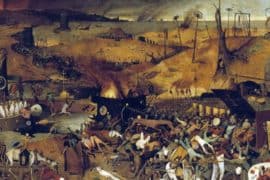Josephus mentions a dozen or more “messiah” figures beginning with Hezekiah/Ezekias c. 45 BCE whom the young Herod defeated whom he variously labels as “brigands” (ληστής) or “imposters” (γόης)—though he calls Judas the Galilean a “wise man” (σοφιστής) and credits him with the founding a the “fourth philosophy” (Jewish Antiquities18.23). Several of these figures are said to have worn the “diadem” (διάδημα)—which indicates royal or “messianic” claims and aspirations. Philo defines γόηςas one who cloaks himself as a prophet but is an imposter (Special Laws 1.315), compare 2 Timothy 3:13. The following list could be expanded but it includes those who are most obviously named and identified. This does not include, of course, the Teacher of Righteousness at Qumran, John the Baptizer, Jesus, or James his brother, who represented scions of the tribes of Levi and Judah or both. And then we could add Barabbas, mentioned in Mark 15:7, and the two crucified “brigands,” (ληστής), one on the right and the other on the left of Jesus (Mark 15:27).
• Hezekiah/Ezekias, defeated by Herod in 47 BCE (Jewish War 1.204-205)
• Judas (aka Theudas) son of Ezekias, 4 BCE/death of Herod (Jewish War 2.56; Acts 5:36)
• Simon of Perea, 4 BCE/death of Herod (Jewish War 2.57-59)
• Athronges the Shepherd, 4 BCE/death of Herod (Jewish War 2:60-65)
• Judas the Galilean, 6 CE/Archaelaus removed (Jewish War 2.118)
• Theudas, c. 44 CE (Jewish Antiquities 20.97; Acts 5:36?)
• James and Simon, c. 46 CE, sons of Judas the Galilean, crucified by Tiberius Alexander, nephew of Philo, who was Procurator 46-48 CE (Jewish Antiquities 20.102)
• “The Egyptian” c. 50s CE (Jewish Antiquities 20.169-171; Jewish War 2.261-263; Acts 21:38)
• Eleazar son of Dineus/Deinaeus, c. 52 CE under Felix (Jewish War 2.253; Jewish Antiquities 20:161)
• Menachem, son of Judas the Galilean, 66 CE (Jewish War 2:433-448)
• Eleazar son of Jairus (ben Yair), commander of Masada, was of the family (γένος) of Menachem (Jewish War 2.447)

For a more complete study of the texts involved in both the expected categories and the candidates for such messianic slots in that time see my complication titled “Two Messiahs the Evidence” and my unpublished article, “One, Two, or Three Messiahs: Dynastic and Priestly Pedigrees from the Maccabees to Masada.”
So far as later Jewish “Messiahs,” see Ari Feldman’s interesting profile “Six Failed Messiahs from Jewish History.” And to really expand things, Wikipedia is compiling an even more extensive list of dozens of Messiahs from Jewish, Christian, and Muslim history, see “List of Messiahs.“









Comments are closed.